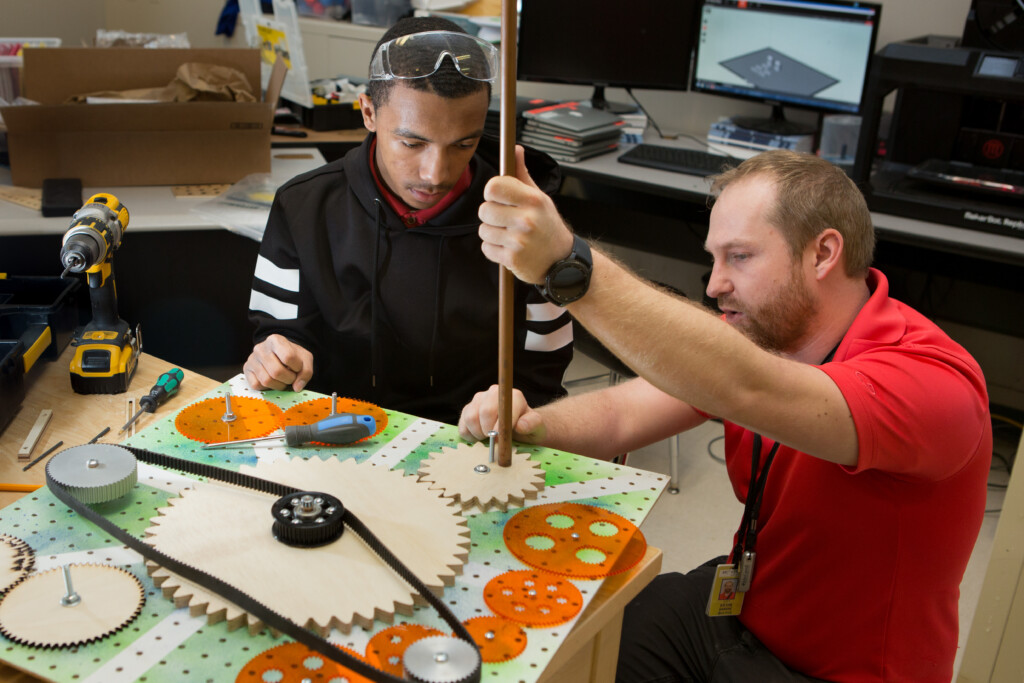Empowering Students to Bridge the Gap Between High School and Career Success
Key Points
-
Access to quality career information is crucial for high school students to make informed decisions and avoid underemployment.
-
Scaling successful career navigation models and tools to high schools nationwide can significantly enhance students’ future prospects and align education with labor market needs.

By: Clare Bertrand & Josh Wright
High school students across the country share a common struggle — navigating how to prepare for a future career. An increasing number of high-quality non-degree pathways adds to the complexity, making it tough for students to choose the best route to equip them with the foundational skills needed to succeed in a fulfilling career.
Students should be empowered to build agency over their own career navigation, but as education and workforce development leaders, we must work to support them and ensure they have the right tools and information to thrive. It’s imperative that we provide clear insights into careers, evolving skills and postsecondary pathways to unlock economic mobility for the next generation of high school graduates.
The Urgent Need for Career Awareness and Skills Alignment
The lack of quality career information in U.S. high schools jeopardizes students’ futures. Without early career awareness, those learners may miss out on pursuing in-demand careers, risking underemployment. Given the average U.S. high school’s counselor-to-student ratio of 1:408, how can we expect students, counselors, and parents to keep up with labor market trends? The individual isn’t the only one struggling here, either. By 2030, the shortage of highly skilled workers is projected to exceed 6.5 million.
With transformative technologies like AI and continued growth in emerging industries, understanding how skills translate to earnings is crucial to accessing family-sustaining wage jobs and closing critical skills gaps.
Existing Models Show What’s Possible
Fortunately, some organizations are leading the way in career transparency and navigation for postsecondary students, and workers more broadly, in search of information.
California’s Sierra College uses the guided pathways model to clarify educational and career goals. Research shows that students with skills aligned to labor market needs are less likely to be underemployed — and the institution’s Career Coach platform provides up-to-date labor market information, connecting the college’s offerings to regional career opportunities.
Similarly, Texas’ workforce commission launched a mobile app to help residents inventory their skills, explore career pathways, and identify their next steps — be it a new job or credential. Texas Workforce Commissioner Bryan Daniel emphasizes the tool’s vision as a way to enable individuals to map their skills to desired jobs and chart a roadmap to get there.
Scaling Career Transparency in High Schools
While progress is happening at the state workforce and postsecondary levels, we need to apply these principles across U.S. high schools as well.
This year, 4 million students received a Career Insights Snapshot with their SAT or PSAT score reports. This snapshot, designed to spark career exploration, highlights growing careers that match students’ skills and provides information on necessary postsecondary education and expected salaries. Early feedback shows these tools increase students’ hope and excitement about their futures and can unlock potential for many.
Statewide initiatives led by the government are also paving the way, with many states working on solutions that can support their high schoolers. For example, the Delaware Career Compass offers a step-by-step guide for middle school and high school students interested in planning their careers. In Illinois, the state’s High School 2 Career tool gives students an interactive way to explore careers, helping them to make informed decisions about their careers after high school. Similarly, Montana Career Pathways was launched to help high school students learn about in-demand career options in the state, and the types of activities students can use to prepare for a career after graduation. And in West Virginia, their Classroom 2 Career Navigator supports individuals by giving them access to information on careers, colleges, military service, entrepreneurship, and on-the-job training.
Zooming past state initiatives into a district level, Ohio’s Lakota Local School District launched the Lakota Cyber Academy, where students gain cybersecurity skills and career exploration opportunities. The academy offers industry-recognized courses, hands-on challenges, and exposure to employers through site visits, mentorships, and internships. This year, Lakota Cyber Academy students earned 40 industry certifications usable immediately after graduation.
The College Board’s Career Kickstart program will scale a similar model nationwide, allowing high school students to pursue college credit and industry-recognized credentials for in-demand careers like cybersecurity.
Moving Forward: Our Path and Responsibility
Standardizing career decisions is impossible, but we can equip students, educators, and families with the insights needed to make the best decisions for them and their future. Our goal should be to build on the positive work already underway to create an ecosystem that ensures students’ choices align with labor market demands — not force them to play private eye, scouring the internet for faulty or incomplete information.
As education and workforce development leaders, we have the tools, and students are ready to start using them, so what’s stopping us from scaling this work today?
Clare Bertrand is the executive director of career strategy and partnerships at College Board, where she leads enterprise-wide efforts to bridge the gap between education and career opportunities.
Josh Wright is the executive vice president of growth for the education and government division at Lightcast, formerly known as Emsi Burning Glass. A former journalist, he regularly writes and presents on the latest trends in the labor market.







0 Comments
Leave a Comment
Your email address will not be published. All fields are required.